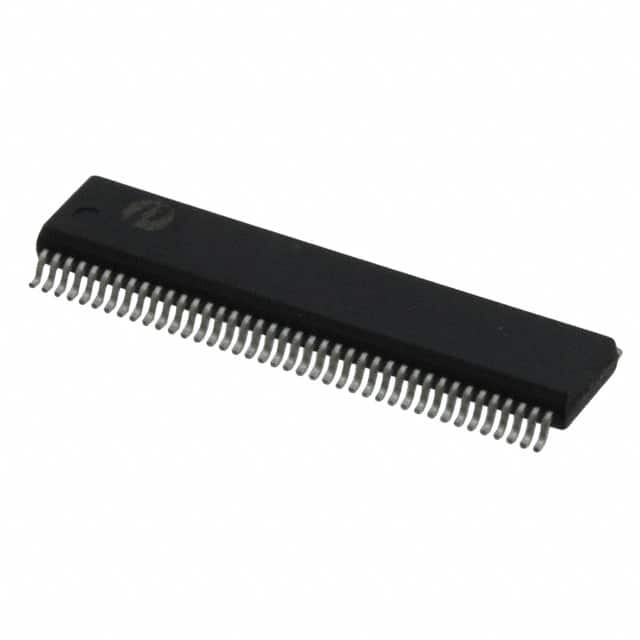PI3VT34X245B
Product Overview
Category
The PI3VT34X245B belongs to the category of integrated circuits (ICs) specifically designed for voltage translation and level shifting applications.
Use
This product is commonly used in electronic systems where there is a need to interface between devices operating at different voltage levels. It facilitates seamless communication between components that operate at different logic levels, ensuring compatibility and reliable data transfer.
Characteristics
- Voltage Translation: The PI3VT34X245B provides bidirectional voltage translation, allowing signals to be translated from one voltage level to another.
- Level Shifting: It enables the conversion of logic levels between different voltage domains, ensuring proper signal integrity.
- High-Speed Operation: This IC supports high-speed data transmission, making it suitable for applications requiring fast and efficient communication.
- Low Power Consumption: The PI3VT34X245B is designed to minimize power consumption, making it ideal for battery-powered devices.
- Compact Package: It is available in a compact package, enabling space-efficient integration into various electronic systems.
Package and Quantity
The PI3VT34X245B is typically packaged in a small form factor, such as a 48-pin TSSOP (Thin Shrink Small Outline Package). It is commonly supplied in reels or tubes, with quantities varying depending on the manufacturer and distributor.
Specifications
- Supply Voltage Range: 1.2V to 3.6V
- Logic Voltage Levels: Compatible with both 1.8V and 3.3V systems
- Maximum Data Rate: Up to 400 Mbps
- Operating Temperature Range: -40°C to +85°C
- Input/Output Capacitance: Typically 4 pF
- ESD Protection: Human Body Model (HBM) ±2000V
Pin Configuration
The PI3VT34X245B features a 48-pin TSSOP package with the following pin configuration:
Pin Number | Pin Name
-------------------|-----------------
1 | OE#
2 | A1
3 | B1
... | ...
24 | VCCA
25 | GND
... | ...
48 | VCCB
Functional Features
- Bidirectional Voltage Translation: The PI3VT34X245B allows bidirectional voltage translation between two voltage domains, ensuring seamless communication between devices operating at different logic levels.
- Automatic Direction Control: It features automatic direction control circuitry that eliminates the need for external direction control signals, simplifying system design.
- Low Power Consumption: This IC is designed to minimize power consumption, making it suitable for power-sensitive applications.
- High-Speed Data Transmission: The PI3VT34X245B supports high-speed data rates up to 400 Mbps, enabling efficient and reliable data transfer.
Advantages and Disadvantages
Advantages
- Enables voltage translation between different logic levels, enhancing compatibility between devices.
- Supports bidirectional communication, allowing data transfer in both directions.
- Compact package size facilitates integration into space-constrained systems.
- Low power consumption extends battery life in portable devices.
- High-speed operation ensures efficient data transmission.
Disadvantages
- Limited to voltage translation and level shifting applications, not suitable for other functions.
- May require additional components for proper signal conditioning in certain scenarios.
- Sensitivity to electrostatic discharge (ESD) necessitates proper handling during assembly and usage.
Working Principles
The PI3VT34X245B utilizes a combination of MOSFET-based level shifters and voltage translators to achieve bidirectional voltage translation. It employs automatic direction control circuitry to determine the direction of data flow and automatically adjusts the voltage levels accordingly. This IC operates by monitoring the input signals and translating them to the appropriate logic levels required by the output domain.
Application Field Plans
The PI3VT34X245B finds applications in various electronic systems, including but not limited to: - Microcontrollers and microprocessors - Memory interfaces - Communication systems - Industrial automation equipment - Consumer electronics
Alternative Models
For voltage translation and level shifting applications, there are several alternative models available in the market. Some notable alternatives to the PI3VT34X245B include: - SN74LV1T34 - TXS0102 - PCA9306
These alternative models offer similar functionality and can be considered based on specific application requirements.
In conclusion, the PI3VT34X245B is a versatile integrated circuit designed for voltage translation and level shifting applications. Its bidirectional capability, compact package, and low power consumption make it suitable for a wide range of electronic systems. However, proper handling and consideration of alternative models are essential to ensure optimal performance and compatibility in specific applications.
Senaraikan 10 soalan dan jawapan biasa yang berkaitan dengan aplikasi PI3VT34X245B dalam penyelesaian teknikal
Sure! Here are 10 common questions and answers related to the application of PI3VT34X245B in technical solutions:
Q: What is PI3VT34X245B? A: PI3VT34X245B is a bidirectional voltage level translator IC used for translating signals between different voltage domains.
Q: What are the voltage levels supported by PI3VT34X245B? A: PI3VT34X245B supports voltage translation between 1.2V and 3.6V.
Q: Can PI3VT34X245B be used for bidirectional voltage translation? A: Yes, PI3VT34X245B is designed for bidirectional voltage translation, allowing signals to be translated from one voltage domain to another and vice versa.
Q: What is the maximum data rate supported by PI3VT34X245B? A: PI3VT34X245B supports data rates up to 100 Mbps.
Q: How many channels does PI3VT34X245B have? A: PI3VT34X245B has 8 channels, allowing for simultaneous translation of multiple signals.
Q: Can PI3VT34X245B be used in both digital and analog applications? A: No, PI3VT34X245B is specifically designed for digital signal translation and may not be suitable for analog applications.
Q: What is the power supply voltage range for PI3VT34X245B? A: PI3VT34X245B operates with a power supply voltage range of 1.65V to 3.6V.
Q: Does PI3VT34X245B support hot-swapping capability? A: Yes, PI3VT34X245B supports hot-swapping, allowing for seamless insertion and removal of the IC without disrupting the system.
Q: Can PI3VT34X245B be used in high-speed applications? A: No, PI3VT34X245B is not designed for high-speed applications. It is more suitable for low to moderate speed signal translation.
Q: What are some typical applications of PI3VT34X245B? A: PI3VT34X245B is commonly used in various technical solutions such as level shifting between different voltage domains in microcontrollers, FPGAs, memory interfaces, and communication interfaces.


